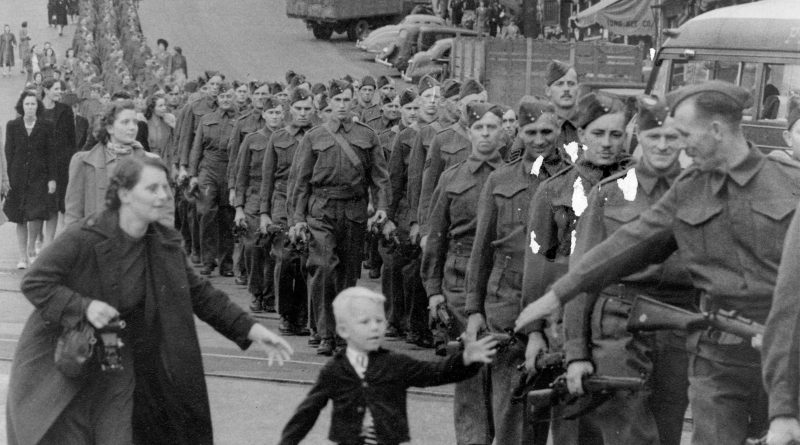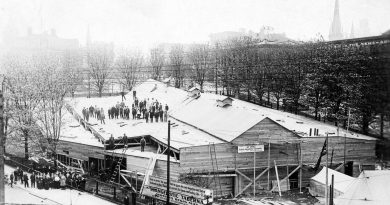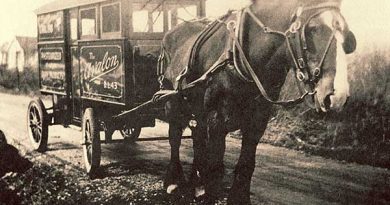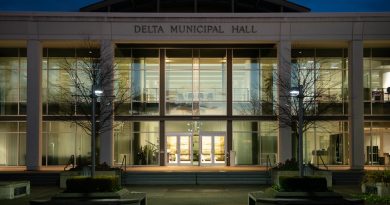1940
Above: The Province’s Claude Dettloff took the famous Wait For Me, Daddy photograph
[Image: Vancouver City Archives]
*****************************************
You’ll note that these years include events listed under “Also in . . .” These are events for which we don’t have a specific date. If YOU know the specific date of an event shown there, please notify us . . . and cite the source! Many thanks!
*****************************************
January 2 The first contingent of the Canadian Active Service Force left for Europe. The second contingent will leave January 2, 1940. No indication of where they left from was published at the time.
January 3 The T. Eaton Co announced that demolition work on the old Hotel Vancouver at Georgia and Granville would start immediately. The company wanted to locate its new department store here. But the hotel was used for vets after the war, so this 1940 plan must have been postponed.
February 16 Orpheum Theatre manager Ivan Ackery proudly hosted the Canadian premiere of Gone With The Wind. Vivienne Leigh’s daughter happened to be attending a private school here, and she was in the audience (unannounced, at her mother’s insistence).
February 29 The Sun merged its radio station with CKWX and the station’s power was increased to reach nearly all parts of B.C.
February Canada’s first all-Chinese-language school was dedicated at 571 East Georgia Street.
March 28 Coal Harbour Shipyards burned.
April 11 Greater Vancouver shipyards began to build corvettes and minesweepers for action in the Atlantic. Some passenger ships were converted.
April 20 Arts writer Tony Robertson was born.
April 21 Ron Barnet, future sportscaster, was born.
May 1 Dal Richards, his 11-piece band and a then-unknown 13-year-old singer named Juliette were booked to replace Mart Kenney at the new Hotel Vancouver’s Panorama Roof ballroom. An initial six-week contract stretched into 25 years of regular performances and broadcasts at “The Roof.” More on this site.
Also May 1 The first May Day festival in Coquitlam.
May 2 Edward Beaton Cook, pioneer contractor, died in Vancouver aged about 87. He was born in 1853 in Blanchard Township, St. Mary’s, Ontario. In March 1886 he moved to Gastown (later Vancouver). He built the Bank of B.C. building, the city’s first bank (it was at Hastings and Richards, had no connection with the present bank of that name) and the Imperial Building at Seymour and Hastings. He built Douglas Lodge at Granville and West 12th Avenue, one of the city’s first large apartment buildings.
May 7 Angelo Calori, the proprietor of Gastown’s Europe Hotel (the famous “flatiron” building at the convergence of Alexander and Powell), died in Vancouver at age 81. Calori was born in Italy in 1860. He came to Victoria in 1882, to Vancouver in 1886. His Province obituary May 8th said “In 1886 he started construction of the Europe Hotel and built a large addition in 1890. In 1908 he added another section—the first concrete building in Vancouver.” These dates are at odds with the generally accepted date of construction: 1908-09. The building still stands in Gastown, with fine stonework, glass and a marble main floor. Calori was a founder (with restaurateur Agostino Ferrera) of the Sons of Italy.
May 9 In UBC ‘s 25th annual convocation the largest graduating class in its history was “capped” at the University theatre. Chancellor R.E. McKechnie congratulated 389 young men and women.
May 10 In Great Britain, Winston Churchill became Prime Minister.
May 28/29 Dunkirk.
June 16 Vancouver celebrated its first Fathers Day.
June 23 The St. Roch (built in North Vancouver in 1928 as an RCMP patrol ship for Western Arctic operations) sailed from Vancouver. Because of wartime security her departure went unreported. She traveled to Sydney, Nova Scotia through the Canadian Arctic. It would take her two years! Her return made her the first vessel to travel the Northwest Passage in both directions.
June 29 The “Big Bend” Highway, linking Revelstoke and Golden and completing the last link in the western section of the transcontinental highway, was officially opened. It was now possible to drive across Canada within Canada.
July 3 Five Canadian Pacific locomotives of the “Royal” class soon will be hauling passenger trains between Revelstoke and Vancouver, said the July 3, 1940 Province (Page 25).
“First of the five, No. 2860, reached Field Monday for delivery to the British Columbia district, and No.’s 2861, 2862, 2863 and 2864 will follow in short order. It was one of this type, No. 2850, which was assigned last summer to the royal train, and it hauled the gleaming blue and silver unit all the way from Quebec to Vancouver in what proved to be the longest single run ever achieved by any locomotive.”
July 8 Our notes show this or July 9 as the date of the arrival of the first British war evacuee children in Vancouver, but the May 7 Sun has a story on the arrival of a few kids. Thousands of children were evacuated from Britain for the duration of the Second World War.
July 16 Future MLA and cabinet minister Darlene Marzari was born.
July 22 Elementary Training School Number 8, part of the Commonwealth Air Training Plan, began training its first batch of pilots.
July The Channel Islands became the only British territory occupied by Nazi Germany. Vancouver’s Channel Islanders’ Society began fundraising activities to help refugees from Guernsey and Jersey.
August 6 The first season of Theatre Under the Stars began in Stanley Park’s Malkin Bowl. The program featured The Geisha, As You Like It and Midsummer Night’s Dream. Reserved seats were 50 cents, unreserved 25 cents. We needed TUTS, because the other news was generally bad, with the Province’s front-page headline reading Nazis Groom Air Blitzkrieg Forces. A big crowd showed up for the performance: 4,000 if you read the Province, 12,000 if you read the Sun.
August 26 The Sun’s Free Salmon Derby began.
September 4 Georgia Sweeney, the Hastings Mills school’s first teacher, died in Santa Paulo, California. Her age at death is unknown to us, although it’s likely she was in her 80s. She was a graduate of a girl’s seminary in Victoria. An accomplished musician and artist, although her admirers noted she “could also milk a cow.” In 1941 her daughter, Esther Cummings, told city archivist J.S. Matthews that her mother was also the church soloist. Her pencil sketches are in the Vancouver City Archives. She taught classes at Hastings Mill School in 1872, then left for San Francisco. She married in the early 1880s. (The spelling “Sweney” is also recorded.)
September 7 Gary Lauk, future MLA and cabinet minister, was born.
Also September 7 The London blitz began as German bombers pounded the city.
September 11 Vancouver writer and educator Sue Alderson was born in New York City. She will move to Vancouver in 1967 to teach at SFU and, as a writer, will become most known for her funny childrens’ stories featuring Bonnie McSmithers. The designer of this web site, Stephanie Davis, loved having those stories read to her when she was a kid. See this site.
September 30 Harry Jerome, who will become a famous sprinter, was born in Prince Albert, Saskatchewan.
October 1 The Province’s Claude Dettloff took the famous Wait For Me, Daddy photograph. It became the most reproduced Canadian World War Two picture. See the story here. Constance Brissenden writes that Dettloff’s photo was named one of the 10 best pictures of the 1940s by Life Magazine. “The unposed shot,” she goes on, “was taken at 9 metres with a 3 1/4 by 4 1/4 Speed Graphic and a 13.5 C.M. Zeiss lens. Exposure was 1/200 of a second at F.8, using Agfa film.”
October 9 John Lennon was born.
October 16 The King George VI Highway was officially opened under that name. (Its name had been the Peace Arch Highway.) There were a lot of people on hand, including Premier Duff Pattullo and Elmer Johnston, president of both the B.C. Automobile Association and the Vancouver Tourist Association, Surrey Reeve J.V. Leyland and a bunch of the usual suspects. “Scores of cars,” the Province reported, “lined the highway on both sides of the Peace Arch to witness the colourful opening ceremony.” (The population of Surrey this year, by the way, was about 15,000.)
October 17 The cornerstone was laid for Shaughnessy Military Hospital.
November 10 “Cap” Hobbis opened his first bicycle store in New Westminster. He will eventually own 12 Cap’s Bicycle shops throughout the Lower Mainland, and will later establish a bicycle museum at the first store.
December 15 Mary Agnes Joe Capilano (her native name Lay-kho-lote, also Lahullette, La-yulette), Squamish matriarch, died on the Capilano Indian Reserve, North Vancouver at age 104. She was born in 1836 at Potlatch Creek on Howe Sound. Her grandfather, George Mathias, had welcomed George Vancouver off Point Grey on June 13, 1792; her father was Chief Skakhult. She was known as “The Indian Princess of Peace,” was an authority on the genealogy of coastal tribes and counted a great orator in her language. She was married to Joe Capilano. Throughout her long life she travelled everywhere by dugout canoe.
December 22 Chris D’Arcy, future MLA was born.
Also in 1940
Vancouver’s Major-General Victor Odlum, about 60, is given command of the 2nd Canadian Division.
In the 1940s the Boeing Aircraft factory in Richmond employed about 5,000 people producing parts for the B-29 Superfortress.
In the 1940s peat moss was extracted from Delta’s Burns Bog by the U.S. government for the manufacture of magnesium fire bombs.
During the war years many single women from the Prairies came to work in Fraser River canneries. They lived in company bunkhouses, each of which had a matron in change. Many of the women married local fishermen and stayed on.
Benedictine Monks bought the old Ceperley Mansion at Burnaby’s Deer Lake for use as a seminary.
Kingsway was widened to four lanes.
Joy Coghill, who will become one of Vancouver’s best-known theatre performers, came to Vancouver from Scotland. She entered into dramatics and attended UBC where she graduated with a B.A. degree.
The Empress Theatre (it stood at the northwest corner of Hastings and Gore) was torn down this year, and thereby hangs a story . . . about Anna Pavlova. She was called the greatest dancer who ever lived, and her 1910 appearance in Vancouver was met with rapturous praise. One tiny memento of her appearances in Vancouver came to light in a curious way many years after she died in 1931. It happens that, during one of her visits here, she had performed at the now-vanished Empress. While they tore that theatre down in 1940, one of the workmen noticed a flash of soft color in the debris. He reached down and picked up a tiny powderpuff. Stitched on it, in faded golden letters, was a single word: Pavlova.
Jung Jin Sow became publisher of the Chinese Times. He would hold that post to 1948.
Banff, Scotland-born James Sinclair, about 32, was elected a Liberal MP for Coast Capilano.
By 1940 Saba’s had become the largest retail house in Western Canada specializing in silks. The Saba family had arrived in Nanaimo in 1888, then moved to Vancouver. Mike Saba (born c. 1861 in Beirut) opened Saba Brothers on W. Hastings with his younger brother Alexander (born c. April 7, 1881 in Beirut) in November 1903. Two years later, the store moved to the 500 block Granville. Mike retired in 1921, selling his shares to Alex.
Malcolm Lowry, novelist, born July 28, 1909 in New Brighton, near Liverpool, England, moved into a squatter’s shack at Dollarton, on the north shore of Burrard Inlet, and began to complete his masterwork, Under the Volcano, counted by many as one of the great books of modern literature.
Albert O. Koch, whose National Dress Co. was Vancouver’s first garment manufacturing plant, started a chain of dress stores called Lauries.
Brantford, Ontario-born Lawren Harris, painter, one of the Group of Seven, moved to Vancouver at about age 54. He is considered one of the great Canadian painters of the 20th century. He lived here until his death January 29, 1970.
Poet and novelist Peter Trower, born in St. Leonard’s-on-Sea, England in 1930 came to Vancouver, aged 10. He’s had a really interesting life. See this site.
Novelist Helen Potrebenko was born in Grand Prairie, Alberta. Her most well-known book, Taxi (1975), fictionalized the struggles to earn a living of a female cabbie in Vancouver, a job she herself had held. See this site.
Australia-born educator Violet Dryvynsyde, who had come to Vancouver with her family in 1930, founded the private Athlone School for Boys with six students. (By the time of her death in 1969, the school at 49th and Arbutus will have 230 students.)
Alma, New Brunswick-born Ernest Cleveland, chief commissioner of the Great Vancouver Water District since 1926, turned 65 on May 12, 1939 and so had reached retirement age. But his work was considered so important that special legislation was passed allowing him to continue on the job. He served for 12 more years. The Cleveland Dam on the Capilano River is named for him.
A cruise ship called the Prince Robert, built in 1930 for the Canadian National Railway’s Vancouver-to-Alaska cruise service, was converted by the Royal Canadian Navy to an armed merchant cruiser in 1939. Marine historian Rob Morris writes that she seized the German freighter Weser off Manzanillo, Mexico in 1940 and brought her to Esquimalt as a prize of war. The Prince Robert then continued her wartime service around the world until 1945.
The Central Median of Cambie Street Boulevard was installed, a legacy of the Bartholomew plan. See the 1928 chronology.
Architectural writer Sean Rossiter says Vancouver architect Ned Pratt was instrumental in locally launching the modern era in house design by doing the drawings this year for artist B.C. Binnings’ largely self-designed West Vancouver house.
Journalist Alan Morley published a collection of stories on earliest Vancouver in The Romance of Vancouver. They had earlier appeared as a series in the Sun.




